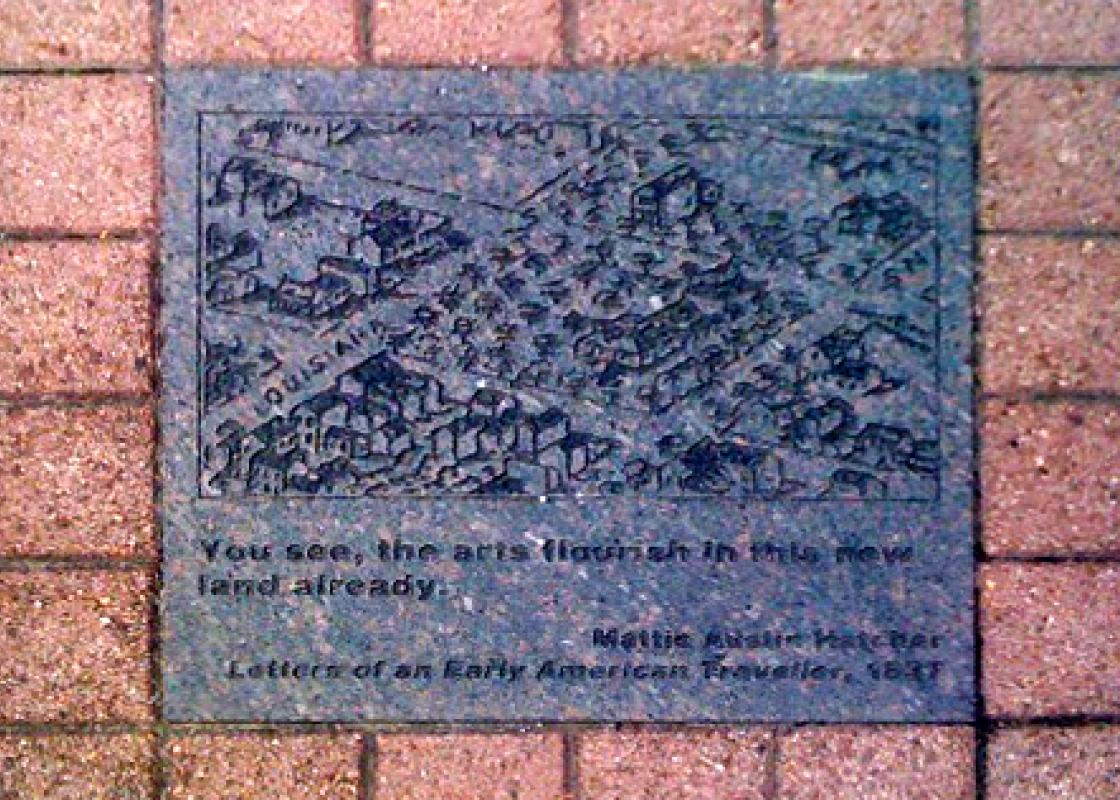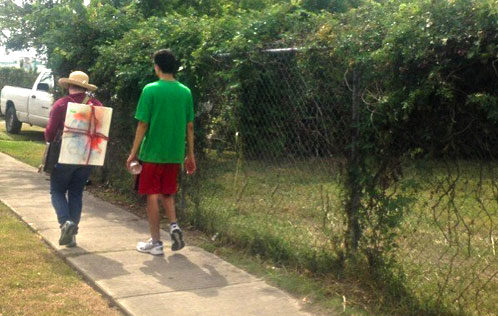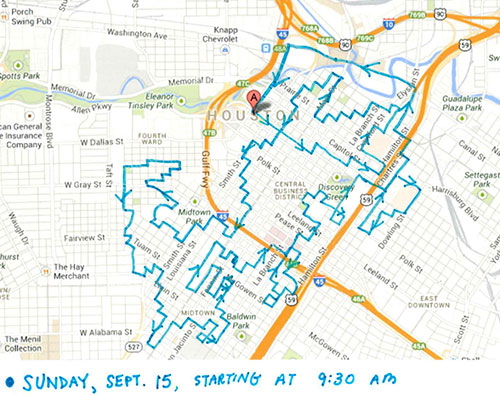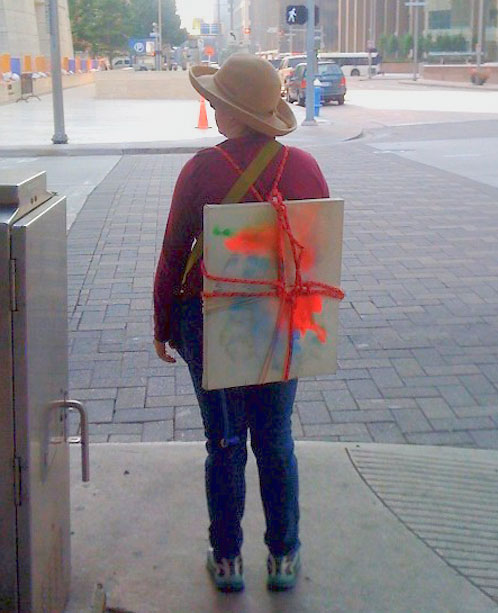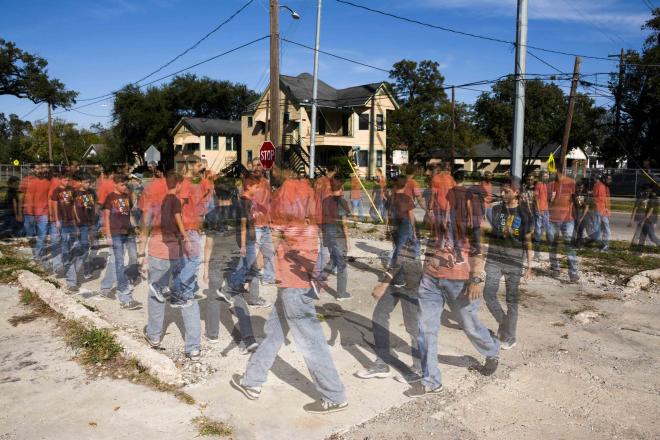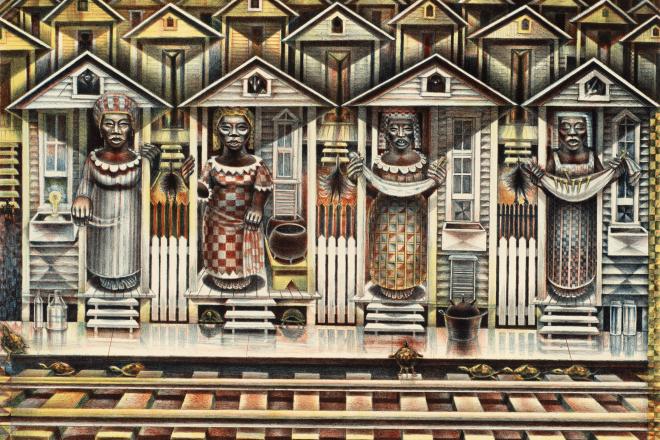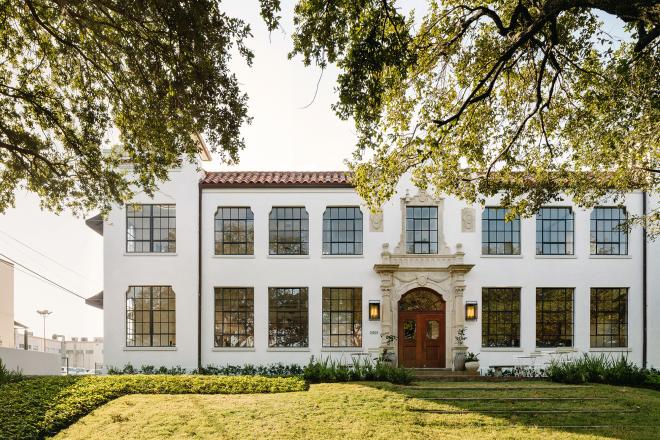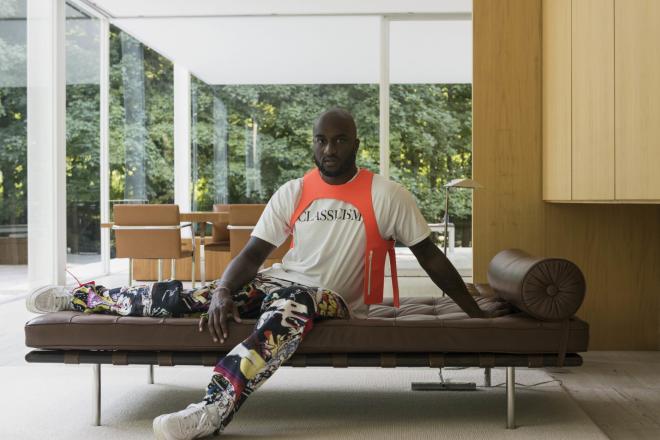It was 9:24 on a Sunday morning, and I doubted whether I was in the right place. I was planning to join the artist Christie Blizard on her walk through Houston, scheduled to start in six minutes. I stood in front of the starting point, City Hall. I proceeded to walk aimlessly around the building’s Art Deco façade, stretching my head around each corner in search of someone resembling an artist but finding only the occasional jogger.
My confusion almost distracted me from the lovely weather. Sheets of bone-white clouds hung high against a blue sky, and a bright sun beamed through the trees lining the block. Sure, the air felt in the low 80s, but that’s balmy for September in Houston. If I can’t find anyone, I thought, I’ll jog a few miles myself.
I came around the reflection pool in front of City Hall when, from a distance, I saw a young woman wearing jeans, a burgundy shirt, and what looked like a safari hat. What made her stand out, however, was the painting she wore like a backpack. As soon as I concluded that this woman was Christie, she started walking toward an intersection. I pushed the large button on my iPhone—9:30. I ran after her, catching up just as the “WALK” sign flickered.
“Excuse me, are you Christie Blizard?”
A bit surprised, she said only, “Yes.”
“My name’s Edward. I’m here to join your walk.”
Her eyes lit up. Her warm hand shook mine.
“Great! I just started.”
The sentence “I just started” confused me. Where was the “we”?
“You’re the first person to ever join me,” Christie said.
She held a squeezable container of sunscreen.
“Would you like some? We’ll be walking for a while.”
I’d completed an art walk before, so I felt certain about what “a while” meant—three, four hours, tops. But then I took another look at the route Christie had drawn. It didn’t appear long, per se—save for a leg in Midtown—but it zigzagged enough for me to answer “Yes.” I didn’t realize it yet, but the sunscreen would have to do its job well into the afternoon.
I said, “Sure,” and began lathering my face, neck, and arms. I asked Christie what was her strategy in crafting the course.
“I just took a pen to the map and started going in different directions.”
“Oh, okay.”
Damn, I thought—my sunglasses and baseball cap were strewn in my trunk, where they’d sit all day.
The route spoke to Christie’s flair for improvisation. Planning ahead or not, she makes things look easy, as skilled artists often do. She develops performance projects (i.e., this walk, done in partnership with the Lawndale Art Center) alongside those in her primary craft: painting. Soon after earning her Master of Fine Arts from Georgia State University, she accepted a tenure-track position at Texas Tech in Lubbock. I asked her about painting amidst such dramatic flatness.
“At first, it was refreshing,” she said, “the wide open spaces. But it eventually wore on me.”
“The sameness of it?”
“Yeah. But I’m thankful for Lubbock. I feel like it pared down my work, made it sharper. And I loved my colleagues at the university.”
I looked at the painting tied to her back. Its bright colors moved playfully, but they showed a mature restraint.
Ultimately, Christie left Texas Tech to pursue another tenure-track job, this one at the University of Texas at San Antonio. She accepted it earlier this year.
“Lubbock has a nice art scene,” she said, “but I couldn’t see myself living there for the rest of my life. San Antonio has a lot of opportunities, and it’s also close to Houston, so I get to show work here. Houston is really the art hub of the state.”
As for how an accomplished painter got into walks, we talked about that as well.
“I’ve always been interested in the art of walking,” she said. “I can’t remember the author, but I read once that, if you walked from France to Italy, you’d learn more than in 12 years of schooling.”
Christie mentioned that, though she’d visited Houston before, she had never seen it, another reason for the walk. Fortunately, the city showed up as eclectic as usual. Close to Downtown, we came across three wildly different churches. The first was Holy Rosary on Milam. Women, girls, boys, and men who looked like boys neatly filed into the stone building, lowering their voices as they entered. The ladies wore autumn dresses while the men wore combinations of polos and khakis, squinting their eyes as they walked in the sun. Familiar enough.
At the Macedonia Missionary Baptist Church on Ruthven, cars piled the block in every direction. Most of the congregation was already inside the pastel building. I heard a voice croon a hymn from deep inside the church’s frame. It was a woman’s voice, so clear and melodic that at first I thought it was a recording. On the curb, an elderly black couple walked toward the entrance, holding hands. When they got within five feet of the building, an usher opened one of the wooden doors and let them in, briefly allowing the singer’s voice to spill onto the street. Then he silently closed the door, and the hymn became distant once again.
The third church was still under construction. With its skeletal roof and blue-yellow stained glass, it stood furtively in an otherwise messy lot. The roof’s beams offered a solemn frame through which to view the sky, while the glass played with the natural light. The structure engaged the world around it.
“This is the best this church will ever look,” Christie said, casting an artist’s eye across it.
More sights came over the next few hours. There was the public park with the psychedelic play-area, including a large teal flower made of steel. There was the zebra-print SUV parked near a Protestant church. There were the grim, paint-chipped night clubs sitting along empty streets.
And the sun. Its at-first charming brightness was now downright hot. At intervals I would wipe my face to keep the sunscreen out of my eyes. Christie pulled out her crumpled map.
“Almost there,” she said. “A few more blocks.”
My lungs were hanging in there, but my feet felt like they were about to swell out of my Asics. Christie had a sweaty sheen, but her breathing was controlled, much like the knot around her painting. I asked about her choice to bring it on the walk.
“I didn’t want it to just hang in a room somewhere,” she said. “I want it to be out in the world.”
Around 3:30, we finished the route at City Hall. By this time, the humidity had lent downtown an underwater quality, intensified by my sluggish legs. I drove Christie to her Ford Escape, parked at the Lawndale Art Center.
Once in the parking lot, I snapped a photo of the painting. The canvas’s edges had frayed during the walk, contrasting beautifully with the sharp colors they contained.
“Thanks for joining me,” she said.
“Thanks for allowing me to join you.”
What modesty, I thought. Christie had let me into her world for several hours, let me see it through her perspective, and yet I was the one being thanked. I would see her drive toward the highway, ultimately toward San Antonio.
On foot, I learned more about a swath of Houston than I ever otherwise would. I recalled that quote about walking from France to Italy. It’s so iron-clad, so laced with romance—if you announced you were visiting Rome or Paris, no one would ask “Why?” But why shouldn’t the maxim ring true for Houston? Throughout my drive home, I brainstormed H-Town versions of the quote. This is my best effort: “If you walked the streets from Franklin to Elgin, you’d learn more than in 12 years of commuting.”


